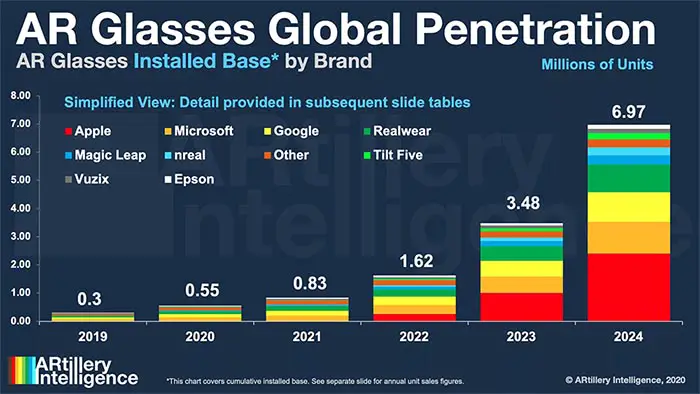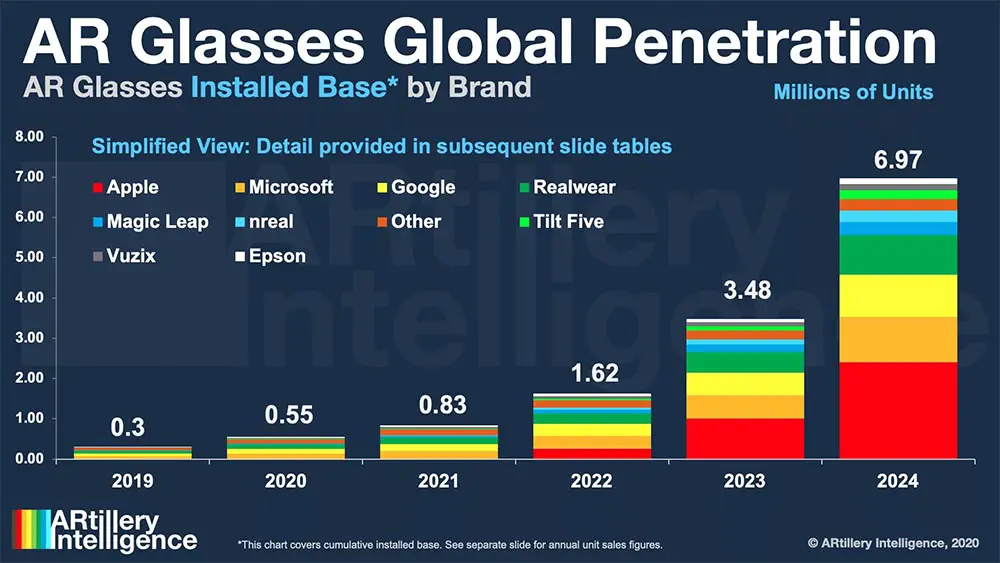The Metaverse Awaits as the World Learns More about a Future Built on Smart Eyewear
The metaverse may have been the word on everyone’s lips in 2021, but it may have contributed to a more muted reception of Meta’s self-appointed first generation of smart glasses: Ray-Ban Stories.
Although the product may not be the finished article as far as augmented eyewear is concerned, the glasses do show us that smart eyewear will take all kinds of essential forms in a metaverse-driven future.

Image: AR Insider
As with many emerging technologies, Ray-Ban Stories doesn’t tick too many boxes when we cast our minds to what truly immersive smart eyewear will look like – but it represents a significant step towards a future technology that packs so much potential that it may ultimately make smartphones redundant.
As the forecasted global penetration of Meta’s closest rivals shows, 2022 is set to host an acceleration of the AR glasses market in which big players like Apple, Microsoft, Google, and Realwear are set to enter the fray.
Although smart eyewear with augmented reality functionality is very much an emerging technology, its potential compatibility with the metaverse can’t be underestimated. Although the metaverse is likely to rely heavily on virtual reality products and huge levels of computational power, AR eyewear will offer invaluable access to the sprawling online ecosystem whilst on the go – or for users who want to be switched on briefly without the rich immersive, fully virtual experience.
We can already see the foundations for the metaverse present within Meta’s first effort to galvanize the smart eyewear industry with Ray-Ban Stories – but let’s take a deeper look at how AR glasses will play a vital role in making the metaverse comprehensively accessible:
Ray-Ban Stories: The First Frontier of the Metaverse
The hyper-interconnectivity of the metaverse can be seen echoed in Ray-Ban Stories. Users are able to communicate with one another by simply saying ‘Hey Facebook’ to alert the glasses to your commands and to be able to send and receive messages as you wish. It’s also possible to make voice calls to friends and family all without having to do anything other than speak.
Perhaps most significantly of all, Ray-Ban Stories allows users to take up to 500 photos and capture short videos up to 30 seconds long on their smart glasses, which can then be uploaded to apps like Instagram and WhatsApp.
Ray-Ban Stories clearly show the direction in which the market is moving when it comes to utilizing smart wearable technology. The industry is focused on delivering experiences that users can share with others across social platforms.
This mimics how we anticipate the metaverse to work in practice. As technology grows to accommodate a vast online space where individuals can digitally interact, play, and work, we’re set to see the emergence of one of the biggest cultural revolutions of all-time.
They may not even have augmented reality technology packed into the lenses, but Ray-Ban Stories certainly gives us a glimpse into how we can be perpetually connected to both digital and physical worlds through wearable technology.
What’s striking is that Meta opted to safeguard the aesthetics behings the smart glasses early on. In striking a deal with Luxottica, the Ray-Ban Stories look like leading fashionable glasses – rather than the bulky headsets that the last generation of smart eyewear largely adopted.
Furthermore, Luxottica also owns leading brands like Sunglasses Hut and sports and prescription leaders Oakley – meaning that the design potential for subsequent releases are virtually limitless. Particularly in the case of Oakley, which is well-known for its sporty Rx glasses that may fit the bill for a popular and durable piece of AR eyewear. Find out more about Oakley prescription lenses.
Although Meta has fired the klaxon for the next smart glasses space race, we’ve already seen market leaders in the field of AR products like Magic Leap and Niantic ramp up speculation about the key role they can play in making the metaverse accessible through their eyewear.
Sending AR Smart Glasses into the Mainstream
In one of the most significant recent developments in the industry, Google recently acquired Raxium, which is a startup that specializes in building microLED display technology for use in AR and VR wearables. The purchase was uncovered by The Indormation but is yet to be publicly announced – although the deal was estimated to be around $1 billion.
Although this isn’t a particularly seismic acquisition for Google, the company’s specialism means that it may play a key role in the development of affordable AR and VR devices that could send smart glasses into the mainstream.
Notably, there are a number of companies at present investing in microLED technology, including the likes of Meta, Apple, and Xiaomi, with all intent on developing AR wearables in acknowledgement of its boundless potential.
Elsewhere in the development of AR smart glasses, it appears that Magic Leap has made a breakthrough in how we may cope with the huge volumes of information we’re set to be bombarded with in the metaverse.
In its upcoming Magic Leap 2 headset, the product uses selective dimming technology that has the ability to make an entity room – or only parts of it – darken instantly to deliver greater contrast on AR effects. For this, sliders can add a dimming effect to views at the level that the user requires.
Not only can this improve focus, the technology can also work to make certain objects more clear by creating an augmented halo around them – making it so that the wider world is all but blocked out entirely.
Whilst the sheer computing power required to fuel the metaverse is still many years away, the technology being utilized in AR eyewear is already here. The potential interconnectivity and visual impact of AR-ready smart eyewear could be strong enough to end our reliance on smartphones. But in the future, it could form the cornerstone of the early metaverse, too.
##




